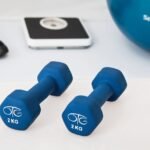Tracking your fitness journey is essential for long-term success. It helps you stay focused, motivated, and aware of your progress over time. When you measure small milestones, you build momentum toward bigger goals and develop habits that last. It also keeps you accountable by showing where you’ve improved and where adjustments are needed. Tracking isn’t limited to just weight loss—it also includes tracking your strength, endurance, flexibility, and mental well-being.
The fitness journey can sometimes feel overwhelming, especially when results don’t show immediately. That’s where tracking comes in. Each step forward—whether it’s shaving seconds off your run time or adding weight to your lifts—counts as progress. This gradual improvement builds confidence and helps you stay committed. Plus, tracking allows you to celebrate the small victories, keeping you motivated for the long haul.
Measuring progress isn’t about perfection; it’s about consistency. Fitness is more than just achieving a number on a scale—it’s about feeling stronger, healthier, and more confident over time. Let’s explore why tracking matters, the best ways to measure your fitness, and how to overcome challenges along the way.
The Importance of Tracking Fitness Progress
Tracking your fitness progress gives you clear insight into what works best for your body, your schedule, and your goals. Everyone’s fitness journey is different, so finding what suits you personally is crucial. For example, some people thrive with cardio-based exercises, while others see better results with strength training. Tracking lets you evaluate what delivers results, making it easier to optimise your routine.
Tracking also provides emotional rewards. It’s easy to become discouraged if you don’t see immediate changes, but logging even the smallest improvements can boost your morale. Whether it’s lifting heavier weights, feeling more flexible, or completing an extra workout session each week, progress tracking keeps you motivated. Each achievement, no matter how minor, offers a sense of accomplishment.
Another advantage of tracking is that it helps you avoid plateaus. Without tracking, it’s easy to stick with the same routine, which may no longer challenge your body over time. By keeping track of your performance, you’ll know exactly when to increase your weights, change your cardio intensity, or try new exercises. Regular adjustments based on tracked data ensure continuous improvement.
Ways to Track Your Progress
Using Fitness Journals
A fitness journal is a powerful tool to track workouts, meals, and emotions. Journaling makes it easier to stay accountable by reflecting on what you accomplished each day. For example, writing down your workout routine helps you identify patterns—like which days are most productive—and recognise when you might need to increase intensity.
Additionally, journaling your meals and mood offers a broader view of your well-being. You might discover that certain foods make you feel more energised or that your sleep improves after specific types of workouts. A journal doesn’t have to be elaborate—simple notes about your performance and reflections are enough to keep you focused.
Tracking Apps
Fitness apps provide a convenient way to monitor progress on the go. Many apps allow you to log workouts, track calories, monitor sleep, and record your hydration levels. Apps like MyFitnessPal, Fitbit, or Nike Run Club help you set and achieve fitness goals while providing data insights, such as calorie trends or weekly workout summaries.
Most apps also offer community features, such as challenges or leaderboards, to keep you motivated through friendly competition. You can also set reminders, which makes it easier to stick to your routine. Some apps sync with wearable devices, giving you a more detailed picture of your daily activity.
Progress Photos
Progress photos offer a visual way to track changes in your body that might not be obvious day-to-day. Weight measurements can fluctuate, but photos show your overall transformation. Take pictures every few weeks, standing in the same pose and wearing similar clothing, to clearly see how your body changes over time.
Photos are particularly helpful for tracking improvements like muscle tone, posture, or fat distribution. Even small physical changes become more noticeable when you compare photos taken weeks or months apart, giving you the motivation to keep going.
Workout Metrics
Tracking workout metrics like reps, weights, sets, and times provides clear evidence of your progress. For strength training, log each session’s weight and the number of reps to see improvements over time. If you’re into running or cycling, track your speed, distance, and heart rate to monitor endurance growth.
These metrics offer tangible proof of how far you’ve come. For example, increasing your squat weight by just a few kilos or shaving a minute off your run time shows you’re making progress—even when the changes feel slow. Having this data helps you set realistic benchmarks for future workouts.
Setting SMART Goals and Measuring Them

The SMART framework is an effective way to set and achieve fitness goals. It ensures your goals are:
- Specific: Focus on a particular outcome (e.g., “I want to run 5km without stopping.”).
- Measurable: Track progress through concrete metrics (e.g., “I’ll improve my 5km time by two minutes.”).
- Achievable: Make sure your goal is realistic based on your current fitness level.
- Relevant: Align your goal with your long-term objectives (e.g., improving cardio for heart health).
- Time-bound: Set a deadline to stay motivated (e.g., “I’ll complete this goal within 12 weeks.”).
For example, instead of saying, “I want to get stronger,” you could aim for, “I will increase my bench press by 10% over the next eight weeks.” SMART goals provide structure, ensuring you stay focused and motivated as you measure each step toward your target.
Small wins matter just as much as big ones. Celebrate every achievement—whether it’s hitting a new personal best or staying consistent for a full month. These milestones build momentum and reinforce positive habits that help you stay committed.
Tips for Staying Consistent with Tracking
Make Tracking a Habit
Consistency is key to effective tracking. Set a specific time each day to log your workouts, meals, or reflections. This could be first thing in the morning or right after your workout. Using habit-tracking apps can also help, as they remind you to stay on top of your routine.
Use Accountability Partners
Having someone to share your progress with makes a big difference. Whether it’s a friend, a workout buddy, or a personal trainer, an accountability partner keeps you motivated. Sharing your successes and challenges builds support, helping you stay committed when things get tough.
Embrace Flexibility
Tracking should support your fitness journey, not make it feel like a chore. Some days you might miss a workout or forget to log your meals, and that’s okay. Be kind to yourself and remember that progress isn’t about perfection. Focus on consistency over time, and adjust your tracking routine as needed.
Overcoming Obstacles in Progress Tracking
Forgetting to Track
Life can get busy, and it’s normal to forget to track occasionally. Setting alarms or leaving reminders in visible places, such as sticky notes or phone notifications, can help. Keeping a small journal or app open on your phone makes logging easier and more accessible.
Feeling Discouraged by Slow Progress
There will be times when progress feels slow, especially if you don’t see immediate results. Focus on non-scale victories during these moments—such as improved energy levels, better sleep, or reduced stress. Remember that fitness progress is not always linear, and every effort counts.
Avoiding Burnout from Over-Tracking
Tracking every detail can become overwhelming. If you find yourself obsessing over numbers, take a step back and focus on the bigger picture. Use tracking as a guide, not a rigid rulebook, and allow yourself breaks when needed.
Conclusion
Tracking your fitness journey one step at a time ensures that you stay motivated and focused on your goals. By measuring progress in multiple ways—through journals, apps, photos, and metrics—you gain insight into what works best for you. Tracking helps you avoid plateaus, celebrate small wins, and adjust your strategy as needed.
Consistency is key, but so is flexibility. Life will throw challenges your way, and it’s important to embrace both the victories and the setbacks. The most important thing is to keep moving forward, one step at a time.
So, grab your journal, set a new goal, or open your fitness app—every step you take brings you closer to the results you want. Your fitness journey is unique, and every bit of progress matters. Track it, celebrate it, and keep striving toward your goals. You’ve got this!





